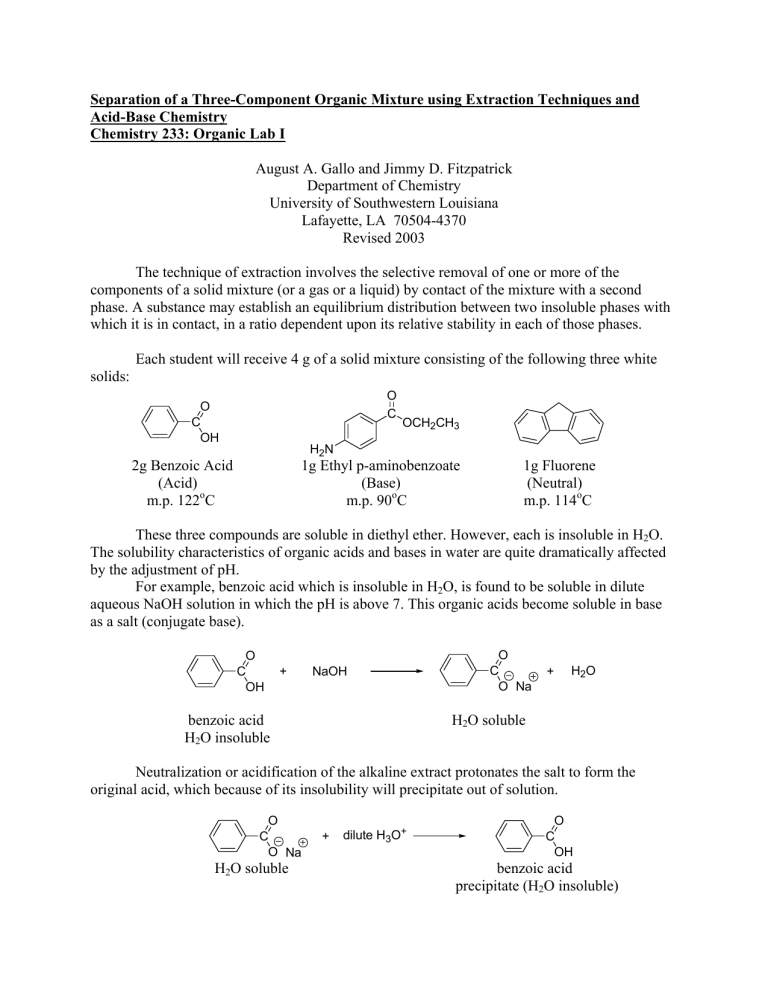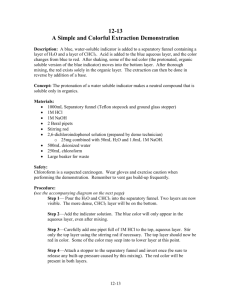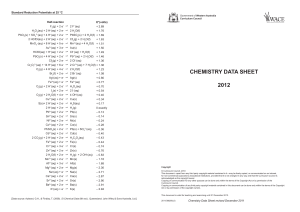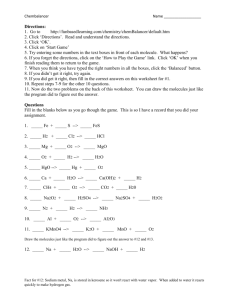Acid-Base Extraction

Separation of a Three-Component Organic Mixture using Extraction Techniques and
Acid-Base Chemistry
Chemistry 233: Organic Lab I
August A. Gallo and Jimmy D. Fitzpatrick
Department of Chemistry
University of Southwestern Louisiana
Lafayette, LA 70504-4370
Revised 2003
The technique of extraction involves the selective removal of one or more of the components of a solid mixture (or a gas or a liquid) by contact of the mixture with a second phase. A substance may establish an equilibrium distribution between two insoluble phases with which it is in contact, in a ratio dependent upon its relative stability in each of those phases.
Each student will receive 4 g of a solid mixture consisting of the following three white solids:
O
O
C
OH
C
OCH
2
CH
3
2g Benzoic Acid
(Acid)
m.p. 122 o C
H
2
N
1g Ethyl p-aminobenzoate
(Base)
1g Fluorene
(Neutral)
m.p. 90 o C m.p. 114 o C
These three compounds are soluble in diethyl ether. However, each is insoluble in H
2
O.
The solubility characteristics of organic acids and bases in water are quite dramatically affected by the adjustment of pH.
For example, benzoic acid which is insoluble in H
2
O, is found to be soluble in dilute aqueous NaOH solution in which the pH is above 7. This organic acids become soluble in base as a salt (conjugate base).
O
C
OH
+ NaOH C
O Na
+ H
2
O
H
2
O insoluble
H
2
O soluble
Neutralization or acidification of the alkaline extract protonates the salt to form the original acid, which because of its insolubility will precipitate out of solution.
O
O O
C + dilute H
3
O +
C
O Na OH
H
2
O benzoic
precipitate (H
2
O insoluble)
Similarly, an organic base that is insoluble in H
2
O will generally be found to be quite soluble in a dilute acid solution in which the pH is below 7.
O
O
C
C
OCH
2
CH
3
+ HCl Cl
OCH
2
CH
3
H
2
N
H
2
N
Ethyl p-aminobenzoate
organic base
H
2
O insoluble
H
Conjugate acid
“Ammonium ion type salt”
H
2
O soluble
If the above acidic solution is neutralized and made basic by the addition of aqueous sodium hydroxide, the conjugate acid is deprotonated to form the original organic base. The base, since it is H
2
O
O insoluble, will precipitate from solution.
O
Cl
C
OCH
2
CH
3 + NaOH
C
OCH
2
CH
3 + H
2
O + HCl
H
2
N H
2
N
H
Conjugate acid Ethyl p-aminobenzoate
H
2
Thus an organic mixture of an acidic, basic, and neutral component can be separated into its individual components through various extraction techniques. If one dissolves the mixture in an organic solvent such as diethyl ether and then extracts the solution with dilute HCl solution, the acid will selectively remove the organic base into the aqueous phase through formation of a
H
2
O soluble salt (the conjugate acid). Likewise, an organic acid can be selectively removed from this mixture by extracting with dilute NaOH solution by forming a H
2
O soluble carboxylate salt
(the conjugate hase). The neutral organic component will remain dissolved in the diethyl ether throughout the extraction process.
Procedure:
1.
Place the contents of the zip lock packet into a dry 100 mL beaker, and then add 50 mL of dry ether. Stir until dissolved, the place this solution in your separatory funnel.
Obtain 130 mL of 3M HCl in a labeled Erlenmeyer flask. Obtain 130 mL of 3M
NaOH in another labeled Erlenmeyer flask.
2.
Add 30 mL of the 3M HCl to the separatory funnel, stopper the funned, and shake vigorously, remembering to vent. Allow the layers to separate. Remove the lower
(aqueous) layer and put it in a 200 mL beaker labeled “acid extract.” Add an additional 30 mL of the 3.0 M HCl to the separatory funnel, shake, vent, and remove the lower (aqueous) layer, placing it also in the beaker labeled “acid extract.”
3.
This beaker now contains the hydrochloride salt of p-amino ethyl benzoate. Now add
70 mL of 3M NaOH to this beaker GRADUALLY while stirring. This addition
should not be done all at once, but should be done over a period of 1-2 minutes.
Avoid letting the solution “boil over.”
4.
Cool the beaker to 15 o C and filter using suction filtration (Buchner funnel), saving the crystals, which are the product ethyl p-aminobenzoate.
5.
Now, the ether layer in the separatory funnel, add 30 mL of 3M NaOH, shake, vent, and separate the layers (lower layer is aqueous).
6.
The lower layer should go into a 400 mL beaker labeled “base extract.” Repeat, using an additional 30 mL of 3M NaOH. Your “base extract” beaker now contains 60 mL of a solution of sodium benzoate.
7.
Add 70 mL of 3M HCl gradually over 1-2 minutes to the base extract in the beaker.
8.
Cool this solution to 15 o C and filter using suction filtration (Buchner funnel), saving the crystals, which are the product benzoic acid solid.
9.
Remove the ether layer from the separatory funnel and dry with MgSO
4
. Place the dried ether layer in a pre-weighed small dry beaker and place this beaker in your locker open to the atmosphere. The ether will evaporate in about one day and the residue will be the product fluorene.
10.
Obtain melting ranges on all dry products. Label them and turn them in, using zip lock packets. Be sure to include the name of the compound, melting range, weight of product, and percent recovery (based upon individual compounds).







